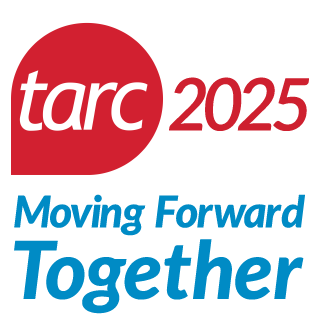TARC is facing significant financial challenges. We’re primarily funded through a small portion (0.2%) of Louisville’s 2.2% annual occupational tax. This allowance was established 50 years ago and has never been adjusted to address rising operations costs or inflation.
In addition, ridership –another important funding source – decreased dramatically during COVID and has yet to return to pre-pandemic levels. Compared with 2019 numbers, today’s ridership is down nearly 40%.
While we’ve tried to maintain our current route network and schedules in the face of these challenges, funding is not keeping up with costs and ridership is down. Therefore, TARC must reduce service or work with the community to find additional funding.
TRANSIT GOALS AND CHOICES
TARC connects our community to jobs, schools, medical appointments, shopping, entertainment and to each other. We take this responsibility very seriously and are committed to providing exceptional service.
However, TARC is facing historic financial challenges and a looming deficit. These fiscal challenges are caused by a combination of limits to existing local funding, minimal support from state governments, expiration of federal support provided during the pandemic, and a challenging environment for transit agencies caused by declining ridership and pressures on wages.
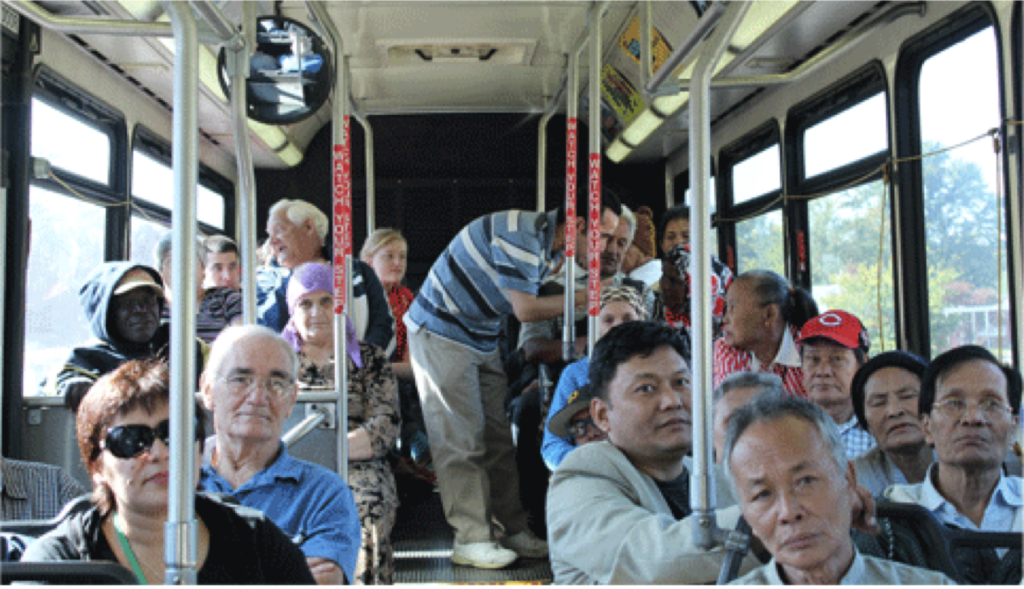
Action must be taken now to ensure TARC can continue to provide important service to the people of Louisville and to ensure the system’s long-term sustainability.
TARC 2025: Moving Forward Together is a key strategy to address this challenge and better meet our shared priorities. It is also an important opportunity to redesign Louisville’s transit network to update and innovate service to better match the current and future needs of the Louisville region.
The Existing Conditions Report is the first step in TARC 2025. It introduces the challenges and realities that TARC faces and is meant to spark a conversation on transit needs and goals as we move forward in this next chapter.
WHAT GOALS SHOULD SERVE TRANSIT?
With this enormous challenge, TARC must start a conversation with the community about what goals it should prioritize. Transit can serve many different goals. It is not possible to excel towards all these goals at the same time. Within a limited budget, communities must carefully consider what kind of goals they want their transit system to fulfill. Reasonable people will disagree about which of these goals is most important. Examples of transit’s goals include:
Some of these goals are only served if transit is very useful so that many people choose to use transit. For example, transit can only mitigate congestion and pollution if many people choose to take the bus rather than drive. Transit is successful at economic goals when it can provide the most people access to the most opportunities. We call these “ridership goals” because they are achieved by designing service to obtain high ridership.
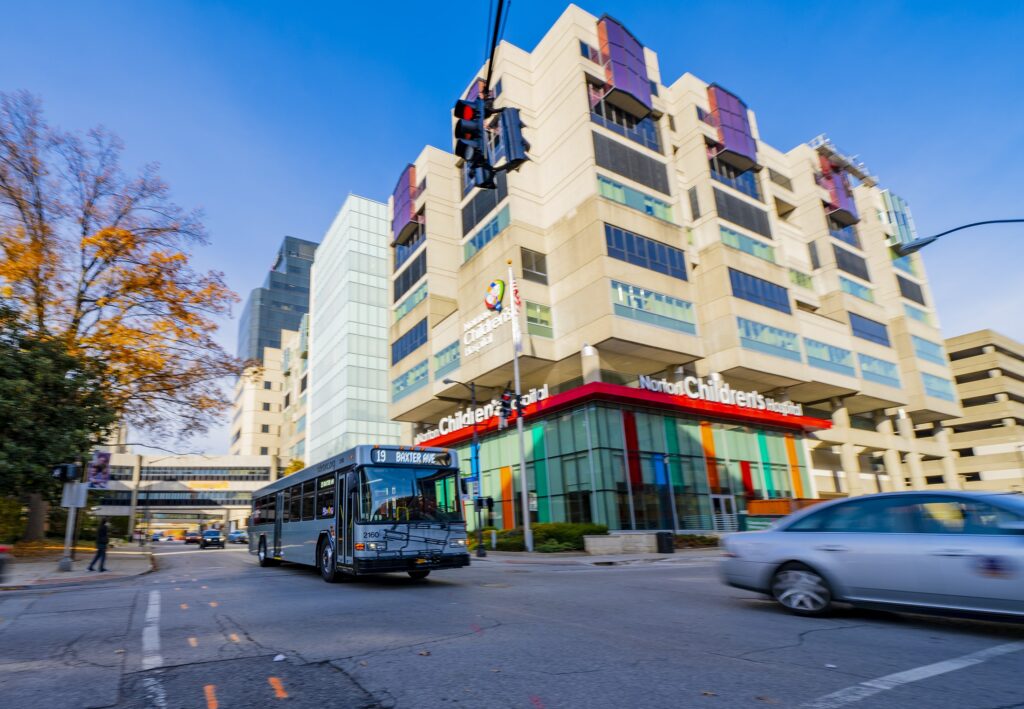
Other goals are served by the simple presence of transit. A bus route through a neighborhood provides residents insurance against isolation. We call these types of goals “coverage goals” because they are achieved in large part by covering geographic areas with service, rather than by high ridership.
In a situation where resources are limited (like what TARC is facing), giving transit a focused set of goals is more important than ever, which often means trading off some goals for others.
IF WE WANT HIGHER RIDERSHIP, HOW DO WE DO IT?
By making transit useful to many people. Useful transit provides more access by reaching more opportunities in a given amount of time.
We can maximize access by:
- Providing high-frequency routes
- Forming a connected network
- Making transit reasonably reliable and fast
- Focusing transit service on places that are:
- Dense;
- Walkable;
- Linear;
- Close to each other, and;
- Have a diverse mix of uses
In Louisville we can see these markets by looking at the combination of the density of people and jobs, street connectivity, and similar factors that are documented in Chapter 3 of the Existing Conditions Report.
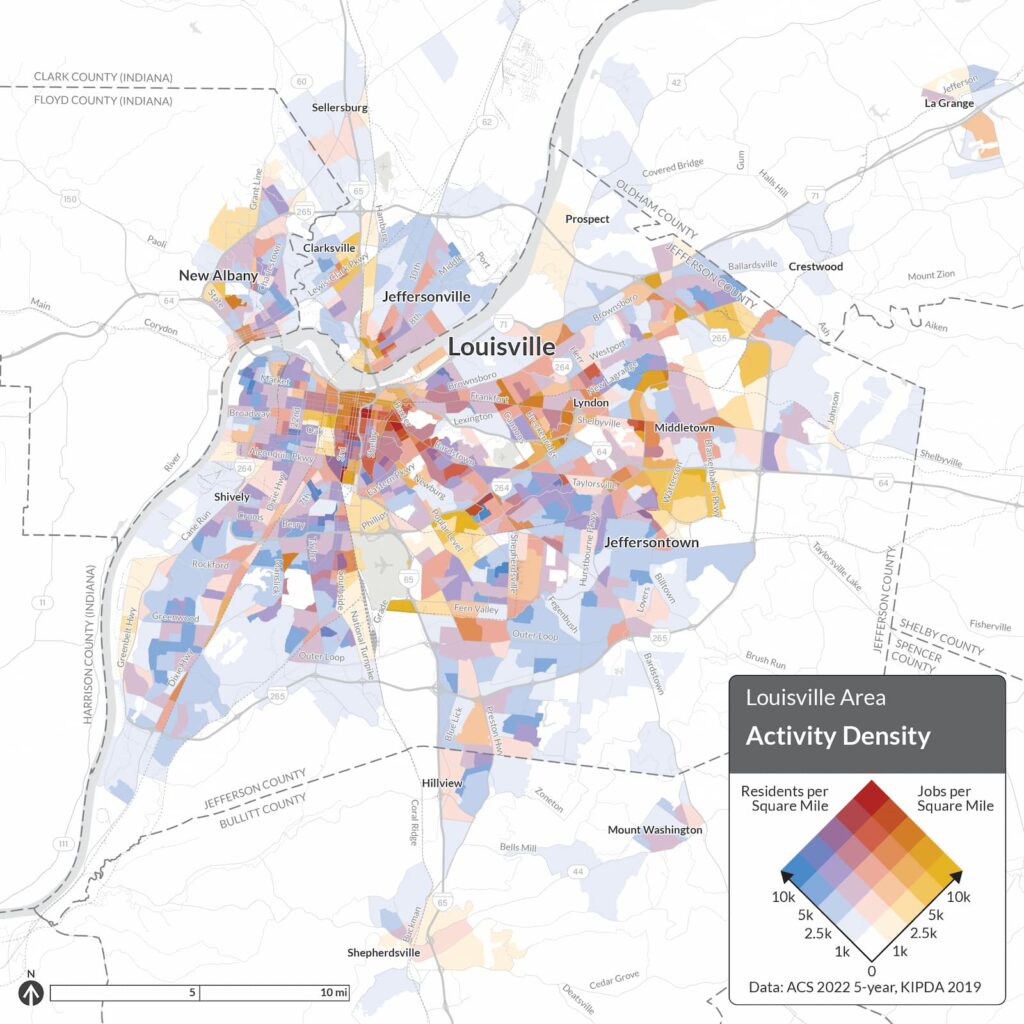
WHERE ARE THE NEEDS FOR TRANSIT?
If you asked a transit planner to draw you a route that helped as many people with limited resources as possible, they would look at where low-income people, seniors, youth and people with disabilities live and where they need to go.
The densities at which these people live matters, because at higher densities a single bus stop can be useful to more people in need. However, the transit planner might also try getting the route closer to small numbers of people. In fact, the more distant and scattered people are, the more isolated they can be and the more they might need access to transit.
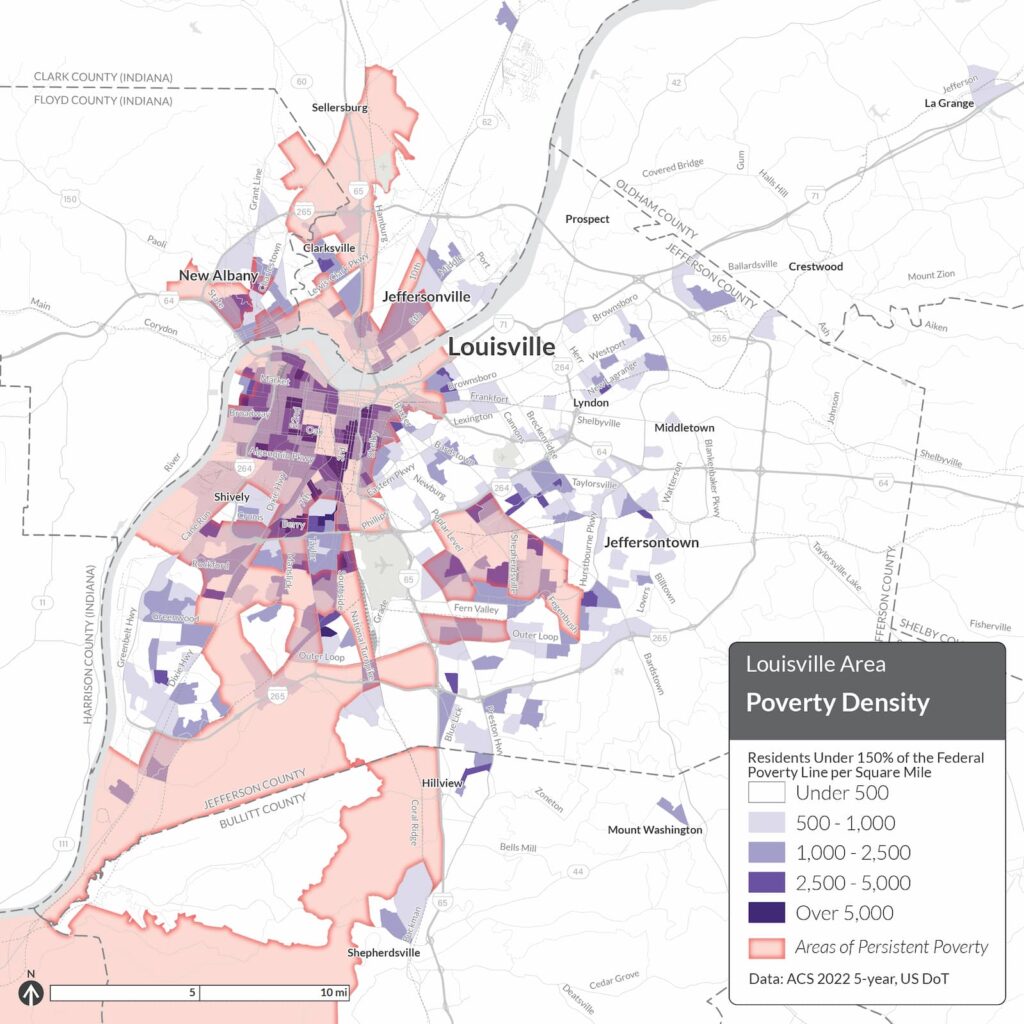
This map shows the density of people in poverty in the region. For more details on the needs for transit in the region, such as where seniors and youth live, see Chapter 3 of the Existing Conditions Report.
HOW HAVE TRAVEL PATTERNS CHANGED?
Recent ridership trends and major changes in travel patterns since the pandemic mean that people now travel at different times and travel in different ways – Louisville is no exception.
Using data gathered from smartphones, connected vehicles, and other anonymous location-based data sources we can paint a large-scale picture of changing travel patterns in the region since 2019. The charts on the page show that “peak hours” have become less pronounced, and more people want to get around in the afternoons and evenings. Compared to 2019, the number of transit trips has almost halved. The substantial decline in ridership since 2013 combined with significant travel pattern changes since the pandemic suggest that TARC’s services should be completely rethought to better meet today’s needs.
WHAT DOES THE EXISTING NETWORK LOOK LIKE TODAY?
Frequency of service, or how long you must wait between buses, is critical to the usefulness of transit. More frequent service dramatically improves access. High frequency reduces travel time by providing several linked benefits:
- Shorter Waits
- Faster Transfers
- Easier Recovery from Disruption
- Greater Spontaneity and Freedom
The existing TARC network has four routes that provide service every 15 minutes or better, as indicated by red lines on the map. A number of these routes (and others) branch to provide added coverage outside the core of Louisville. However, most of TARC’s weekday service consists of routes with frequencies worse than every 30 minutes, going as low as every 75 minutes. These are the light blue, green, and the thicker tan lines on the map.
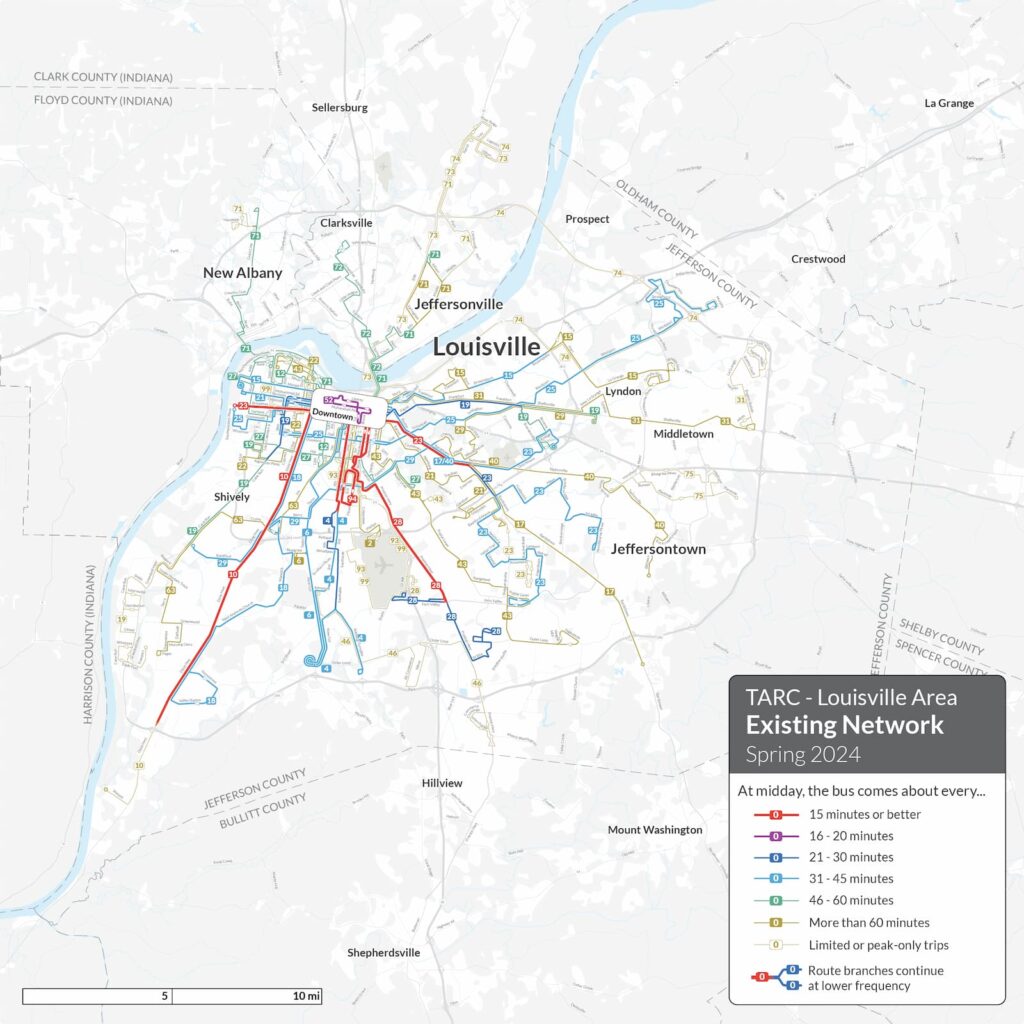
For more details on the existing transit network, see Chapter 4 of the Existing Conditions Report.
HOW SHOULD WE DESIGN THE REGION’S BUS NETWORK?
It depends.
Imagine we are designing a transit network for this fictional city. The lines are roads and the dots are people and jobs.
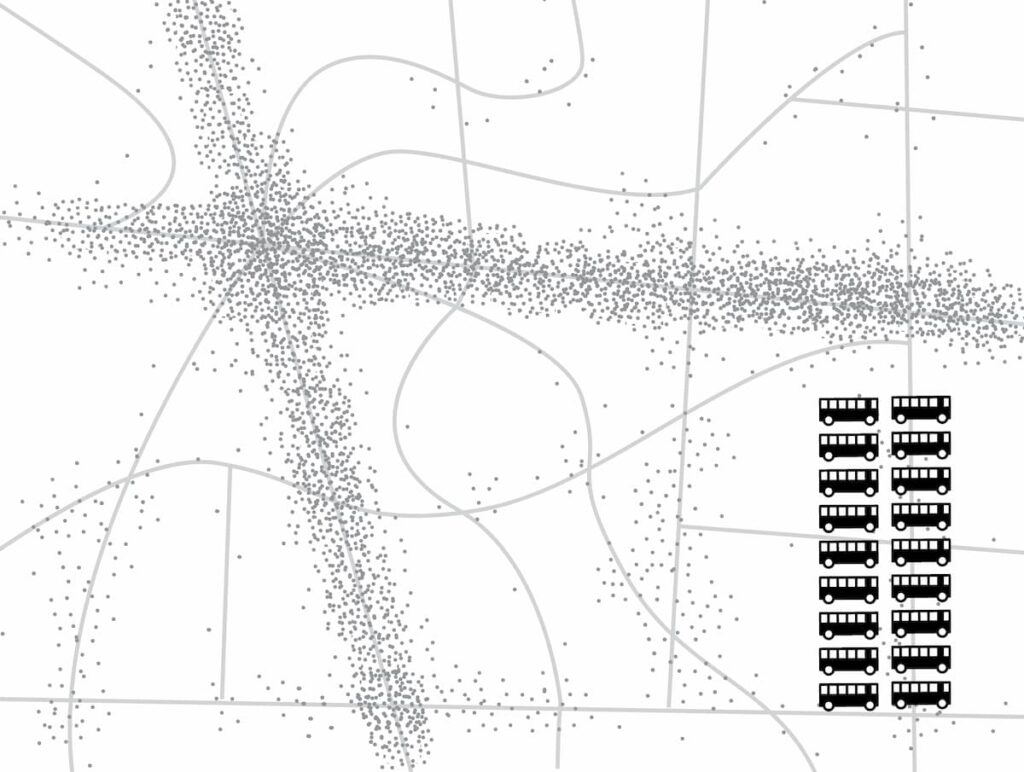
Places with more dots close together are dense with activity. More people want to travel to and from those places. That dense activity is concentrated along the main roads.
The buses in the image are all the resources we have to run transit.
Ridership
If our goal is to get the most ridership from our system, we would concentrate transit resources where most people and jobs are close together. We can then provide high-frequency service that is very convenient and encourages people to ride transit in those areas.
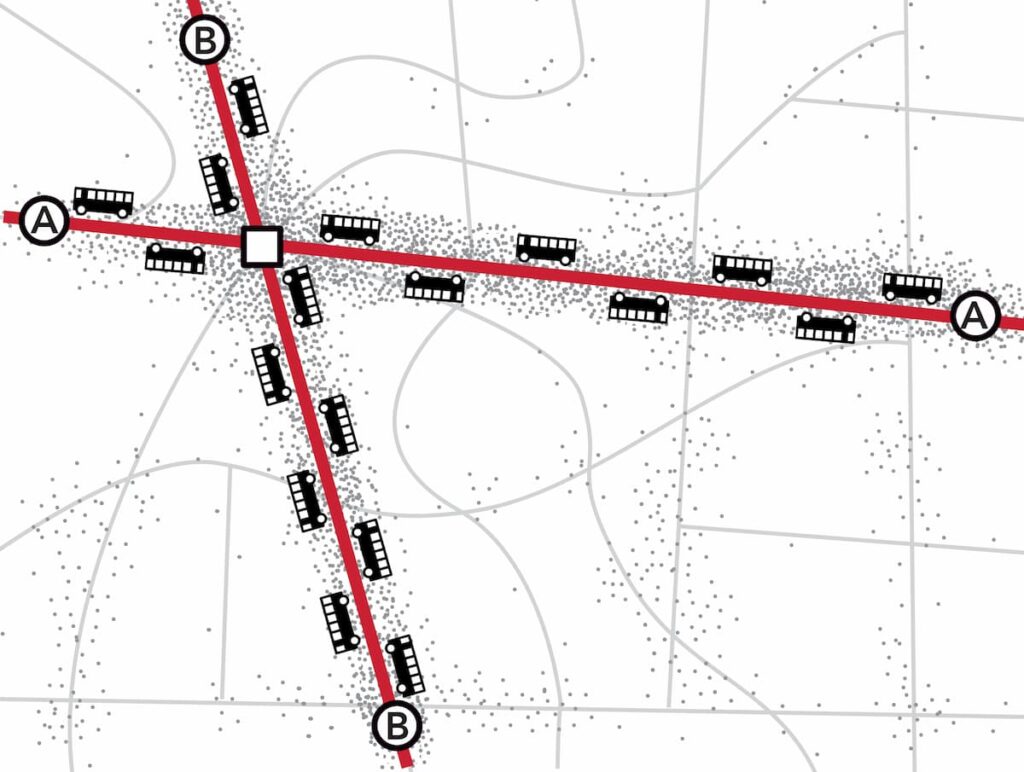
Coverage
If our goal is to get transit coverage in as many areas as possible, we will have to spread transit resources out. Routes cannot be as frequent, and so not many people would find transit useful and convenient. However, there would be some transit coverage in as many areas as possible.
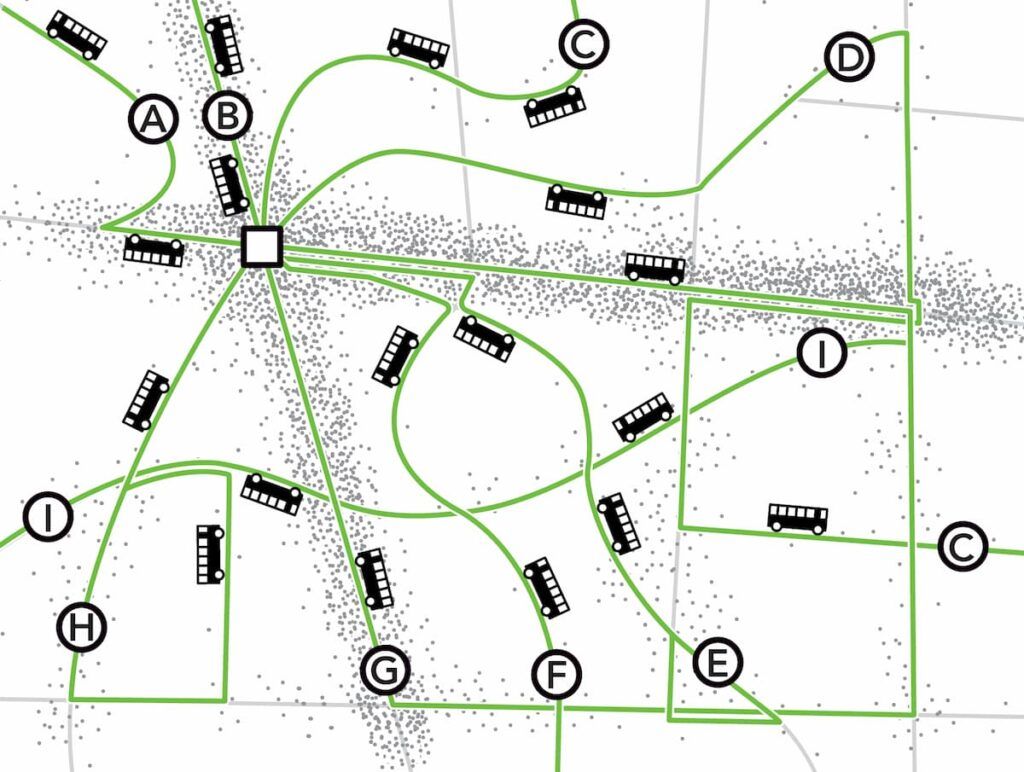
Both goals are important, but in the context of a limited budget and ensuring the long-term sustainability of the transit network, shifting towards one goal means shifting away from another.
WHAT LEVEL OF RESOURCES IS ENOUGH?
Wrestling with the choice of balancing ridership and coverage—and changing the transit network to meet clear goals that match the community values, may improve people’s sense that the transit network is delivering on their goals and is worth further investment.
However, it’s also worth considering whether the level of investment is enough to meet the community’s overall goals. The Louisville region has grown, with people and jobs moving farther out from the core since the dedicated tax for TARC was approved in 1974. With that expanded footprint has come more costs to serve the larger range of developed places in the region.
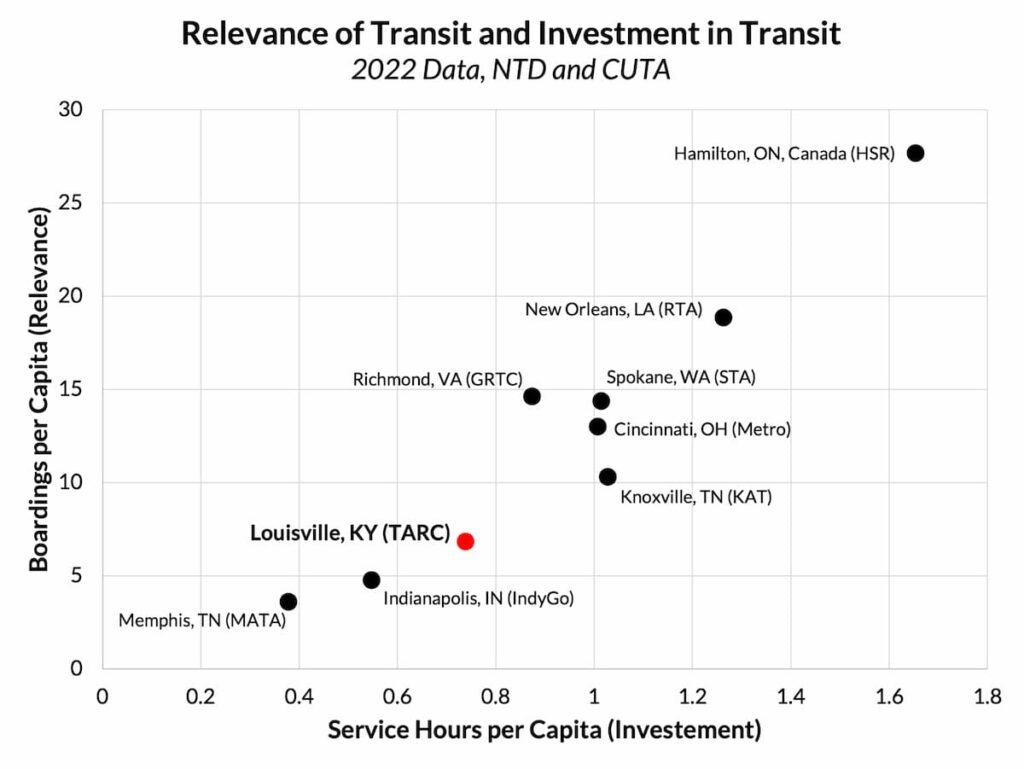
The chart on the above compares the number of boardings per capita (how relevant an agency is for their population) versus service hours per capita (how much an agency invests in transit). The chart shows that “if you invest, they will ride” when it comes to transit service.
Louisville could increase transit frequency and ridership without investing in more service.
However, this would require cutting and reallocating low-ridership services – there’s no way around it. However, if there were additional revenue, ridership could be increased without cutting low-ridership service. In the difficult fiscal condition that TARC faces, additional funding would protect existing riders and the community from potentially painful service reductions.
Help TARC decide what to do, take our survey.
STUDY TIMELINE
The TARC 2025: Moving Forward Together study began in February 2024 and will be completed in Spring 2025. We are currently the Capacity Building Phase of public engagement. Starting in late summer we will start our first major round of public engagement on the Network Concepts that will show what TARC could do in the future.
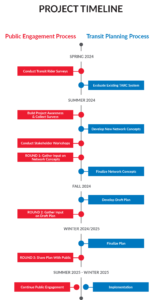
THE TARC 2025 TEAM
TARC 2025: Moving Forward Together is managed by TARC staff, with input from across the organization. Additionally, TARC has hired a team of national and local experts to develop the plan in consultation with the public. The consultant team is led by Louisville-based Schmidt Associates in collaboration with Jarrett Walker + Associates (transit system planning), Gresham Smith and EHI Consultants (public engagement), and Rasor (project communications).
